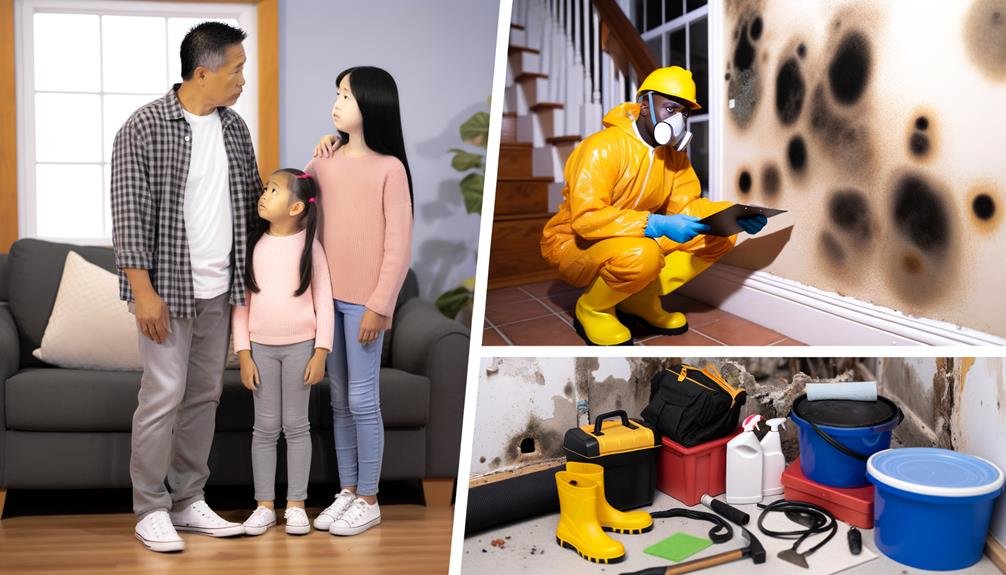Mold can rapidly invade your home, thriving in damp environments and causing serious health risks. You might notice signs like musty odors, visible mold, or water damage. Symptoms of exposure include respiratory issues and allergic reactions, making timely remediation vital. DIY methods can be effective for minor issues, but professional services offer specialized tools and expertise to guarantee thorough removal. They likewise help prevent future growth by addressing moisture problems. Protecting your home and health requires swift, informed action. Uncover fundamental tips for selecting the right remediation service and maintaining a mold-free environment.
Understanding Mold and Its Risks
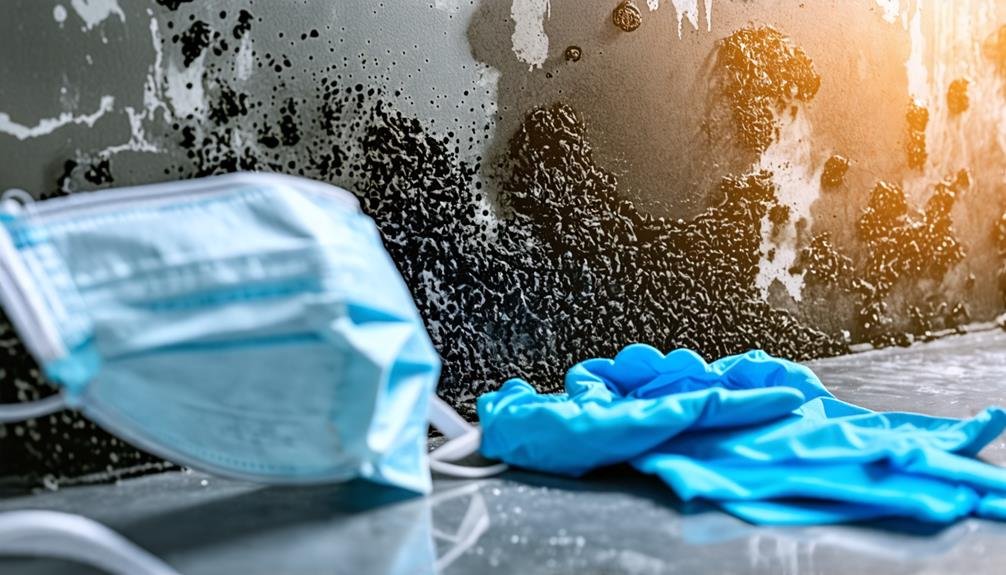
Mold thrives in damp, warm environments and poses significant health risks, including respiratory issues and allergic reactions, making it fundamental for you to understand its dangers. There are various mold types, such as Aspergillus, Cladosporium, and Stachybotrys, each with unique characteristics and potential health effects. Understanding these types allows you to recognize the specific risks associated with exposure.
The mold lifecycle consists of several stages: spore germination, growth, and reproduction. Spores, which are microscopic and easily airborne, can settle on damp surfaces, initiating the growth phase. As mold colonies expand, they can produce mycotoxins, which are harmful substances that further intensify health issues. It's critical to recognize that mold can proliferate in as little as 24 to 48 hours under the right conditions, making swift identification and remediation important.
Common Signs of Mold Growth
When you suspect mold growth, pay close attention to three key indicators: an unpleasant musty odor, visible mold spots, and signs of water damage. These factors often signal an underlying moisture problem that promotes mold proliferation. Identifying these signs early can help you address the issue before it escalates.
Unpleasant Musty Odor
Detecting an unpleasant musty odor in your home often signals an underlying mold issue that requires immediate attention. Musty odors typically arise from mold growth in damp or poorly ventilated areas, like basements, bathrooms, or kitchens. Identifying the sources of these odors is essential for effective mold prevention.
Here's a breakdown of common musty odor sources and their potential solutions:
| Musty Odor Source | Potential Causes | Mold Prevention Tips |
|---|---|---|
| Basements | High humidity, poor ventilation | Use dehumidifiers, improve airflow |
| Bathrooms | Leaky pipes, shower moisture | Fix leaks, use exhaust fans |
| Attics | Roof leaks, insulation dampness | Inspect roofs, ventilate spaces |
| HVAC Systems | Dirty filters, condensation | Regularly clean filters, maintain system |
Being proactive helps you avoid serious health risks and property damage. Whenever you notice a musty odor, investigate its source immediately. By addressing these issues, you can create a healthier living environment and protect your home from the potential hazards of mold growth.
Visible Mold Spots
Visible mold spots can quickly pop up in various areas of your home, serving as clear indicators of moisture problems that need immediate attention. Identifying these spots is vital for effective mold remediation. Common visible mold types include black mold, green mold, and white mold, each varying in appearance and potential health risks.
To guarantee accurate mold identification, utilize mold identification techniques such as visual inspections and surface sampling. Check damp areas like bathrooms, kitchens, and basements for discoloration or fuzzy growth. Pay special attention to corners, ceilings, and any surfaces that have been exposed to water.
If you notice discoloration on walls or ceilings, or if your surfaces feel slimy, it's likely time to investigate further. Mold thrives in warm, humid conditions, and spotting it early can prevent more extensive damage.
Always remember that mold can likewise be hidden behind walls or under flooring, so regular checks are fundamental. By actively monitoring for visible mold spots, you take a proactive step in protecting your home and health, guaranteeing a safe living environment for you and your loved ones.
Water Damage Presence
Water damage often reveals itself through several common signs that indicate potential mold growth, such as discoloration, peeling paint, and a persistent musty odor that permeates the air. If you notice water stains on ceilings or walls, they could be signs of leaks from plumbing or roof damage, which are frequent water damage sources. Pay attention to any warped or buckled flooring, as this can likewise indicate hidden moisture.
Moreover, if you detect a strong musty smell, it's a telltale sign that mold may be lurking nearby, even when visible spots aren't present yet. You should likewise check areas that are prone to dampness, like basements and bathrooms, as these spaces often harbor moisture, creating ideal conditions for mold growth.
To combat these issues, water damage prevention is essential. Regularly inspect your home for leaks, maintain proper ventilation, and control humidity levels. By being proactive and addressing any signs of water damage promptly, you can protect your home and health from the detrimental effects of mold. Remember, swift action is key to maintaining a safe living environment.
Health Effects of Mold Exposure
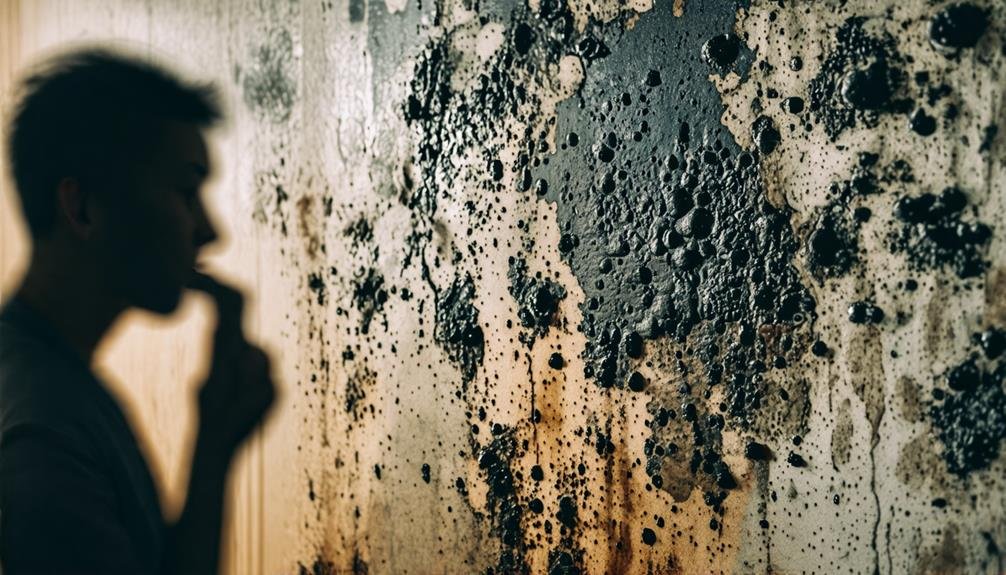
Mold exposure can lead to a variety of health issues, particularly for individuals with respiratory conditions, allergies, or weakened immune systems. When mold spores enter your body, they can trigger mold allergy symptoms such as sneezing, coughing, nasal congestion, and skin irritation. For those with asthma or similar conditions, exposure can worsen existing problems, leading to more severe respiratory distress.
The effects of mold exposure aren't just immediate; long term health effects can manifest after prolonged exposure. Chronic respiratory issues, sinus infections, and even neurological symptoms may arise. Some individuals report fatigue, headaches, and difficulty concentrating, which can severely impact daily life.
If you notice mold in your home, it's essential to address it promptly. The longer you permit mold to thrive, the greater the risk to your health. Understanding the potential consequences of mold exposure empowers you to take action, ensuring that your living environment remains safe and healthy. Don't underestimate the importance of safeguarding your home; your well-being depends on it. Prioritizing mold remediation is an important step in protecting not just your property, but your health as well.
Importance of Timely Remediation
Addressing mold issues promptly is crucial, as delaying remediation can worsen health risks and lead to more extensive damage within your home. The longer you wait, the more likely mold spores will spread, increasing the remediation timeline and complicating the restoration process. This can not only affect the structural integrity of your property but also intensify health impacts for you and your family.
Here's a breakdown of the importance of timely remediation:
| Timeframe | Potential Damage | Health Impacts |
|---|---|---|
| 1 week | Minor surface damage | Allergic reactions may begin |
| 2 weeks | Structural damage starts | Respiratory issues worsen |
| 1 month | Extensive mold spread | Chronic health conditions develop |
| 3 months or more | Severe property damage | Long-term health effects |
DIY Mold Removal Techniques
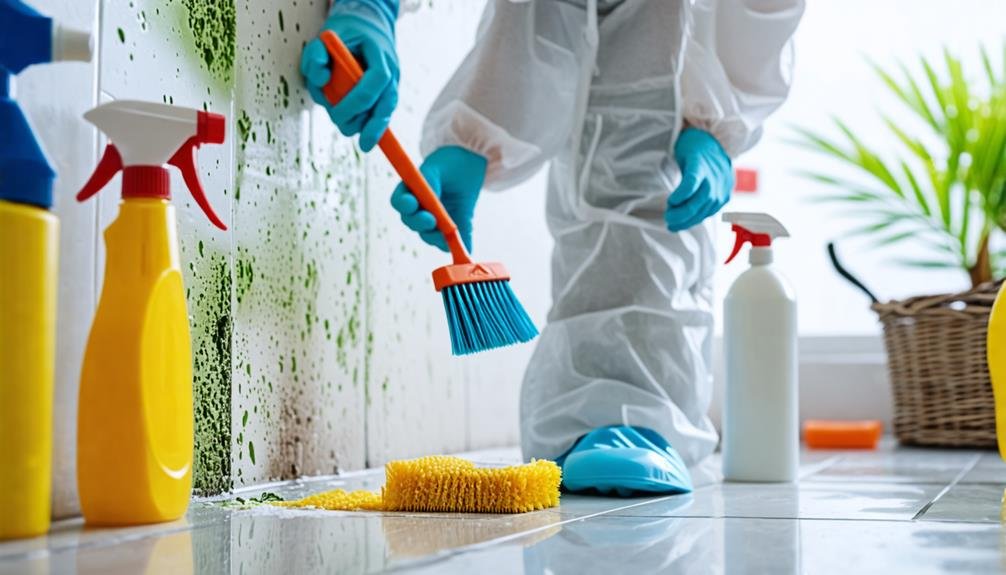
Often, homeowners can tackle minor mold issues by employing effective DIY removal techniques that focus on eliminating visible growth and preventing future infestations. Start by identifying the affected areas, typically damp spaces like bathrooms or basements. Use a solution of one cup of bleach mixed with a gallon of water for non-porous surfaces. Apply it with a spray bottle or sponge, allowing it to sit for at least 10 minutes before scrubbing and rinsing.
When handling mold, always prioritize safety precautions. Wear appropriate personal protective equipment (PPE), including gloves, goggles, and a mask to avoid inhaling spores. Verify proper ventilation by opening windows and using fans to circulate air during the process.
For porous materials like drywall or carpeting, you may need to discard items beyond salvage. Once you've removed the mold, address moisture issues to prevent recurrence. Consider using dehumidifiers in damp areas and fixing leaks promptly. Regularly inspect your home for mold growth and maintain low humidity levels to improve mold removal efforts and safeguard your health. By taking these steps, you can confidently protect your home from mold infestations.
Professional Mold Remediation Services
When it comes to mold issues, relying on professional mold remediation services is crucial for effective and safe removal. These experts follow a structured process that includes assessment, containment, and thorough cleanup to guarantee your environment is mold-free. Understanding the importance of their expertise can help you make knowledgeable choices for your property's health.
Importance of Professional Services
Professional mold remediation services are essential for effectively eliminating hazardous mold growth and preventing long-term health risks associated with exposure. These professionals possess specialized training and equipment to assess and address mold issues thoroughly. When you hire experts, you're not just paying for their time; you're investing in your safety and home's integrity.
Cost considerations play a significant role in the decision-making process. While initial expenses might seem overwhelming, think about the potential costs of ignoring mold problems. Structural damage and health-related expenses can far exceed the price of professional remediation. Plus, many companies offer service guarantees, reassuring you that they'll address any residual issues that arise post-treatment. This commitment reflects their confidence in delivering quality service.
Steps in Remediation Process
The mold remediation process involves several critical steps designed to effectively identify, contain, and eliminate mold while minimizing disruption to your home environment. First, professionals conduct a thorough inspection to pinpoint mold sources and assess the extent of contamination. Using advanced technology, they identify hidden mold that may not be visible.
Next, they implement remediation techniques to contain the affected areas. This often includes sealing off rooms with plastic sheeting to prevent spores from spreading. Safety precautions are paramount during this phase; workers wear protective gear, including respirators, to safeguard against inhalation of harmful mold particles.
Once containment is established, professionals begin the removal process, employing specialized tools and cleaning agents for effective mold eradication. After mold removal, they dry and dehumidify the area to prevent future growth, often utilizing industrial-grade fans and dehumidifiers.
Preventing Future Mold Growth
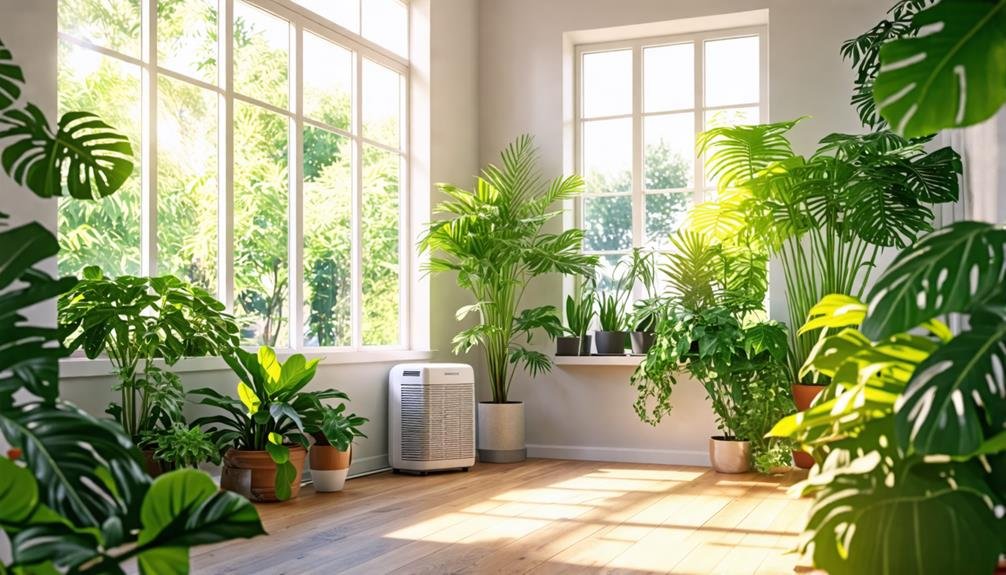
To prevent future mold growth, it's essential to control moisture levels and guarantee proper ventilation in your home. Start by monitoring humidity levels; ideally, they should remain between 30% and 50%. Use dehumidifiers in damp areas like basements or bathrooms to achieve effective humidity control. Regularly check for leaks or water accumulation, as even small amounts of standing water can promote mold growth.
Next, focus on ventilation improvements. Verify that exhaust fans are installed in kitchens and bathrooms, and use them during and after cooking or showering to expel excess moisture. Open windows whenever possible to increase airflow and reduce humidity. Furthermore, consider using air purifiers equipped with HEPA filters to capture mold spores and improve air quality.
Inspect your home for areas where airflow is restricted, such as behind furniture or in closets. Rearranging these spaces can boost air circulation. Finally, clean and maintain your gutters to prevent water from seeping into your home's foundation, which can create a mold-friendly environment. By taking these steps, you'll greatly reduce the risk of future mold infestations and protect your home and health.
Choosing the Right Remediation Company
When selecting a mold remediation company, it's crucial to reflect on their experience, certifications, and customer reviews to guarantee effective and safe treatment of your home. A certified company not only assures you of their expertise but also improves your peace of mind. Here's what to focus on:
- Remediation Certifications: Verify the company holds relevant certifications from recognized organizations. This shows they're trained to handle mold safely and effectively.
- Experience: Look for companies with a proven track record. Their history in the field can greatly impact the quality of service you receive.
- Customer Reviews: Read testimonials and feedback from previous clients. Positive experiences can indicate reliability and effectiveness.
- Evaluating Estimates: Don't just settle for the lowest bid; assess what's included. A thorough estimate should detail the extent of work, materials used, and timeframe.
Conclusion
In summary, addressing mold growth in your Union City home is essential for both your property and your health. Ignoring the problem could lead to catastrophic consequences, like turning your sanctuary into a hazardous wasteland. Whether you choose DIY methods or hire professional services, timely intervention is key. Remember, prevention is always easier than remediation, so take proactive steps to keep mold at bay. Your home deserves to be a safe haven, not a breeding ground for mold!

